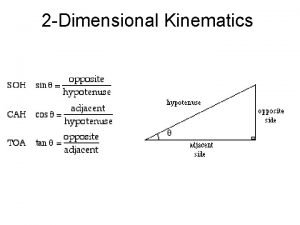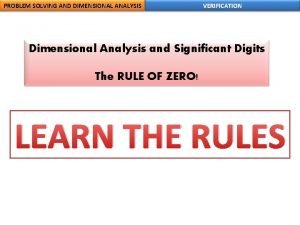Dimensional Analysis Dimensional analysis is a strategy for








- Slides: 8

Dimensional Analysis Dimensional analysis is a strategy for performing conversions by multiplying by ratios that equal one. Basic Principles of Dimensional Analysis ØYou can multiply a quantity by 1 without changing its value. Ø 2 equal quantities create a ratio that equals one.

The Process of Dimensional Analysis o. Set up conversion ratios so that the units being converted cancel out.

Calculate Usain Bolt’s speed in miles per hour. He ran a 100 meter dash in 9. 58 seconds (10. 4 m/s). Conversion factors: 1000 m = 1 km, 1. 6 km = 1 mile, 10. 4 meters seconds x 1 km 1000 m x 1 mile 1. 6 km x 60 seconds x 60 min =. 1 min 1 hr 23. 4 miles hours

Tips for Dimensional Analysis Always include your units and cross off the ones that cancel out so that you can double check your work, making sure you did not miss a step or invert any ratios. For some problems, the same unit may be used for more than one type of measurement. For these cases, you will need to include both the unit and what is being measured. =

Some ratios are normally given in a conventional orientation, such as miles per gallon, so that the information can be more easily interpreted. For example, a higher miles per gallon ratio means better fuel efficiency. However for problem solving purposes these ratios can and may need to be inverted. If a car gets 25 miles per gallon, it also uses 1 gallon per 25 miles.

Solve the problem with your table partner: A car has a fuel efficiency of 20 miles per gallon and is used to drive 15, 000 miles per year. Determine how many pounds of carbon are released into the atmosphere each year by the car. • Each gallon of gasoline burned releases 5 lbs of carbon dioxide. • Every lb of carbon dioxide contains 0. 27 lbs of carbon 15, 000 miles year x 1 gallon x 5 lbs CO 2 x 0. 27 lbs carbon 20 miles 1 gallon 1 lb CO 2 =1, 012 lb carbon

Discuss with your table partner Determine the formula for percent change One formula you will need to have memorized for the AP exam is the percent change formula. Determine the formula and solve the question below. (Consider what this term means and how you would find what percentage of the original the change represents. ) The level of CO 2 in the atmosphere was 317 ppm in 1958. It is currently 400 ppm. What was the percentage change in carbon dioxide during that time period? Fill in your answers on the next slide.

The formula for percent change is: Final- Initial x 100 Initial The atmospheric level of CO 2 percent change from 1958 to present : 400 -317 x 100 = 26 % 317














